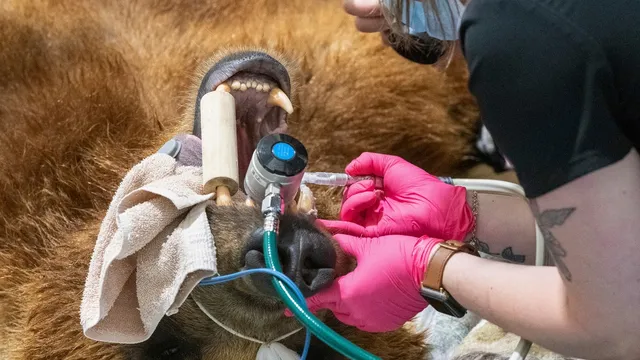
Brown bear Tundra gets world’s largest dental crown after tooth injury
2025-06-25 19:10- Tundra the brown bear required dental surgery after fracturing his tooth in 2023.
- He was fitted with the largest dental crown in history, created specifically for him.
- This first-of-its-kind procedure was completed successfully, and visitors are encouraged to see Tundra.
Express your sentiment!
Insights
In the United States, specifically at the Lake Superior Zoo in Duluth, Minnesota, a remarkable dental procedure was performed on Tundra, an Alaskan brown bear, who had suffered a fractured canine tooth. The procedure took place recently, with the decision being made after Tundra reinjured the area that had previously undergone a root canal. The veterinary team, led by Dr. Grace Brown, undertook this significant dental intervention, which involved fitting the bear with a new titanium alloy crown tailored to protect the tooth for the remainder of Tundra's life. The creation of this crown was facilitated through a collaboration of veterinary specialists and Crown Creators, who utilized a wax cast of Tundra's tooth to construct this world-class dental fixture. The team, comprising experts from Minnesota Veterinary Dental Specialists as well as Creature Crowns, dedicated their efforts voluntarily to ensure Tundra's recovery and provided care to him amidst his dental challenges. Upon successful completion of the procedure, zoo staff expressed their pride in the teamwork and innovation that culminated in this achievement. Dr. Grace Brown remarked on the uniqueness of the procedure, indicating that this dental crown was indeed the largest ever created for a bear. After the hour-long operation performed under sedation, Tundra emerged with a new gleaming smile. The zoo staff noted his return to normal behavior following recovery, reassuring visitors and animal enthusiasts that safety protocols were adhered to during the procedure, even including a member of the zoo's armed response team being present to ensure the bear's and staff’s safety. Tundra, now six years old, has been part of the Duluth zoo community since he was just three months old, following the unfortunate loss of his mother. As he stands approximately eight feet tall on his hind legs and weighs around 800 pounds, significant precautions were necessary during his dental surgery. The zoo hopes to attract visitors to witness Tundra’s historic new smile, as well as provide an opportunity to emphasize the value of animal dental health.
Contexts
Veterinary advancements in large animal dentistry have significantly evolved over recent years, leading to improved health and welfare for horses, cattle, and other large animals. These advancements encompass enhanced diagnostic techniques, innovative treatment options, and the incorporation of technology in dental care. The integration of ultrasound and digital radiography has allowed veterinarians to obtain precise assessments of dental conditions that were previously difficult to diagnose. This improvement in diagnostic accuracy has enabled more effective treatment planning, ensuring that veterinarians can address dental diseases early and thoroughly, thus preventing further complications that could arise from untreated conditions. Moreover, advancements in anesthesia and analgesia have transformed the way dental procedures are performed on large animals, contributing to better pain management and overall patient comfort. Veterinarians can now utilize new anesthetic protocols and equipment geared toward the unique physiology of large animals. This allows for procedures to be performed in an outpatient setting with less stress on the animal. As a result, routine dental care, which is essential for the prevention of periodontal disease and other complications, is more readily accepted by both practitioners and animal owners alike. Innovative surgical techniques and tools have also emerged in large animal dentistry, which allow for more effective treatment of complex dental issues. Veterinary dental specialists now use advanced instruments such as dental lasers, which not only improve the precision of procedures but also promote faster healing and reduced risk of infection. Additionally, veterinary education and training programs have expanded to include advanced dental care techniques, recognizing the importance of expertise in this specialized field. As a result, more veterinarians are equipped with the knowledge and skills necessary to perform advanced dental procedures reliably. The impact of these advancements is reflected in the improvement of general health and quality of life for large animals. Regular dental evaluations and treatment not only support the overall health of large animals but also improve their performance, nutritional intake, and longevity. As research continues to unfold in the areas of dental care for large animals, the veterinary community is poised to embrace further advancements that will continue to enhance the standards of care for these animals. By focusing on prevention and effective treatment through the use of innovative technologies and techniques, the field of large animal dentistry is set to improve dramatically in the years to come.